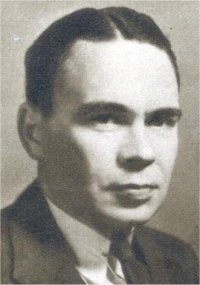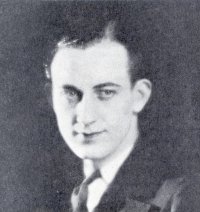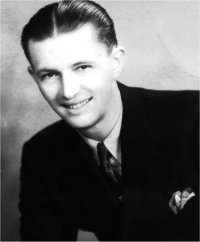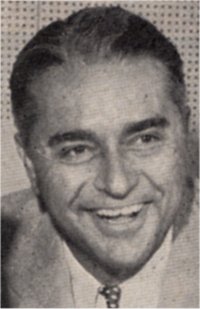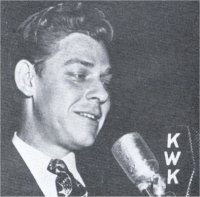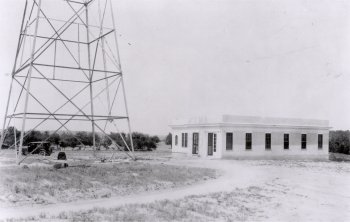Radio Articles
Harold Bolande, Announcer, Musician And Actor Finds Happiness In Radio
By Nancy Frazer
The heartiest voice of all – that characterizes Harold Bolande’s particular claim to glory and all of you who hear him daily over KMOX will agree.
There is a secret for that particular trait and that lies in his interest in radio and in his unfeigned friendliness for everyone. He is just as friendly and enthusiastic when his voice first comes over the air for the Early Morning Band Wagon as it (sic) is at noon for the Farm Service Hour and later at night when he introduces The Citizen of the Southwest. He lives, thinks and eats radio – eats it, of course, when his many devoted listeners send him samples of their cookery and helpful suggestions.
He’s a Yankee, too, and so disclaims the reserve usually attributed to that Eastern section of the country. He is from Norwich, Connecticut. He early saw the light, however, and came out to the middle west when he was only eighteen.
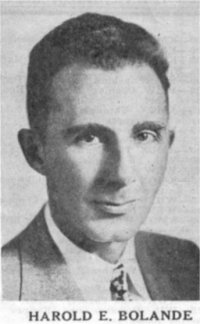
Harold has held all sorts of colorful jobs in the intervening years until he finally found the niche that suited his many and peculiar talents.
He had been talking into a dictaphone for quite awhile until one of the stenographers in a large music house where he was employed remarked one day that she was always happy when she had to type his work for his voice recorded clearly. The idea intrigued him and he decided to make a few records and play them back. He was the only one that was surprised that he sounded so well (sic) for his associates and friends had known it all along!
It occurred to him to go to KMBC and try out and his voice was typified as one having perfect pitch. He became a guest announcer, then a full-time one and then served as program director and chief announcer at the various stations in Kansas City.
When KMOX was putting on a circus program last April, they invited him to come and try out for the place of “barker” – and the rest was easy. He became a regular announcer here specializing on the Farm Service Hour. He used to live on a farm and loves everything connected with it so he has an earnest wish to help and entertain farm folks.
But that isn’t all. One night when my own program ran a bit short, I was amazed to see him dart over to the piano and beautifully “fill” the few seconds before another feature. He is an accomplished pianist, playing both by ear and note. He studied voice at the New England Conservatory of Music. And you should see him take Sad Sam’s accordion and make it do musical flip flops!
He learned to play the accordion when he was in the music business just for the sheer love of learning new things. He does a rollicking good job of wangling tunes out of one too.
Recently he has been interested in dramatics and is taking the leading role, and very ably too, in the series of “The Scoop” dramas heard every Tuesday and Thursday on KMOX. That delights him and he is spending long hours on mastering the dramatic art.
About five feet ten, he has almost black curly hair, keen friendly grey-blue eyes and a spontaneity that is impossible to resist. He likes to think up new features and production ideas – in short everything that has any connection with radio work.
Probably his greatest admirer is his own eleven-year-old son Donald whose greatest aspiration is to be a radio announcer. Harold plays football with his youngster, teaches him the diction necessary for the radio and in odd moments teaches him French. “Bolande” came from the French name “Boulande” and Harold’s heritage enables him to speak a good brand of his father’s native tongue. He served with the 35th division in France, and so augmented his knowledge of the language.
Just to give you an idea of his versatility, here are some of the positions that he has held: jewelry salesman; assistant chief clerk, telephone company; shipping clerk; specialty salesman; time keeper, pipeline company; pianist in a theater; hotel bellboy and waiter; stacker during harvest; cowboy riding fences and herding cattle; credit manager; sales promotion man, music company; radio, piano and book salesman; radio work including manager, program director and announcer; also radio salesman; two and one half years USA-AEF 35th Division; plays piano, piano-accordion and mandolin; and his favorite sports are: hockey, tennis, billiards and baseball and swimming.
But fortunately he is here at KMOX making new friends every day in the work that he loves the very most!
(Originally published in Radio and Entertainment 11/26/1932.)
